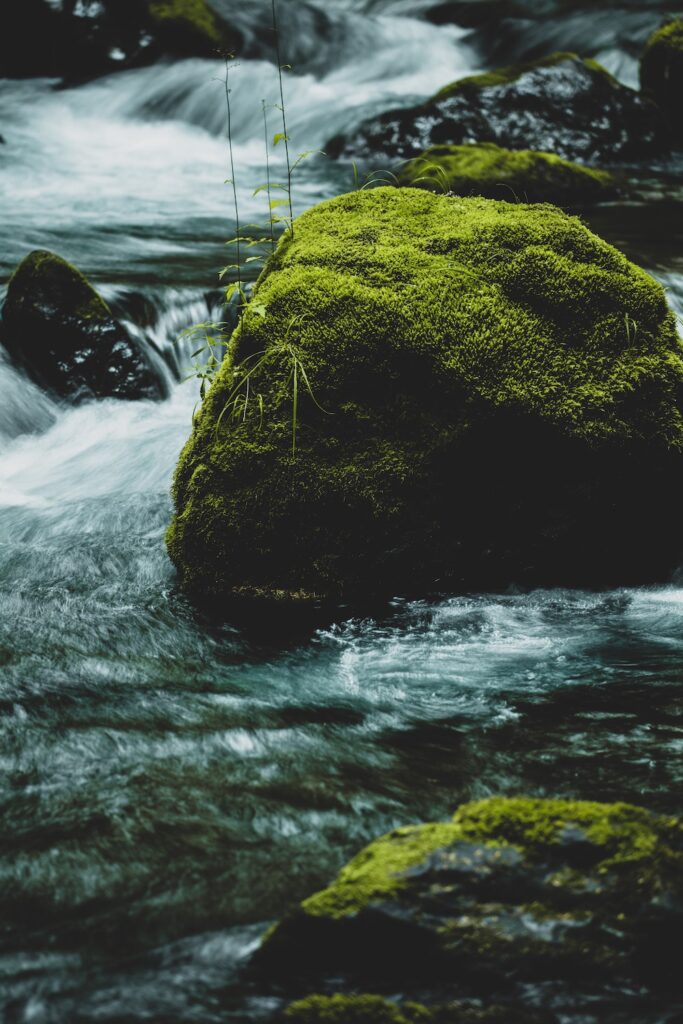
Imagine hiking through a lush green forest that opens up to a whole empty lot that’s covered with moss. It creeps up trees and sprawls across the ground, mixing and matching green hues to create intricate and unique patterns on the brown earthy floor.
It’s organic, authentic, and exactly the type of zen design concept that’s currently trending in the interior design community.
Inspired by the expression of art in nature, moss art has exploded in popularity—finding its roots in celebrity homes like Khloe and Kourtney Kardashian’s and bridging the gap from cottagecore chic to a mainstream interior design trend.
Best of all, it’s an affordable and low-maintenance way to add greenery to any space in the form of bowls, wall art, or terrariums.
If you’re looking for new interior design inspiration, look no further. Moss art is officially the new design trend you need in your life.
Moss Design Trend 101
The Origins of Biophilic Design
Before we dive into the different types of moss aesthetic, it’s important to first explain why moss has grown in popularity over the past several years.
To clarify, incorporating natural elements such as moss into living spaces is hardly new. The ancient Greeks relied heavily on natural imagery within their architecture, using rosettes, leaves, and animal industry, while the Umayyad Mosques built between 705–715 in Damascus, Syria, prioritized spaces with natural light, fountains, and organic materials.
This incorporation and prioritization of nature dwindled with the rise of the Industrial Revolution, as humans were forced inward toward urban spaces and away from natural, green settings. Unlike the Greek and Syrian style of architecture, the Industrial Revolution was a time characterized by steel-based structures and metallurgy.
Now, biophilic design such as moss art is bringing us back home.
Since the 1980s, the concept of biophilic design has exploded in popularity. First coined by social psychologist, Eric Fromm, biophilia is considered “the innate tendency to focus on life and lifelike processes.” Since then, interior designers have started introducing plants, biomorphic patterns, natural sounds and scents, and organic lighting into interior design spaces. Beyond its aesthetic looks, biophilic design also offers tangible health benefits to mental health and wellbeing—helping to reduce stress, enhance creativity, and increase productivity.
If you’re looking to take your biophilic energy to the next level, then consider these new moss-specific trends. Discover More on Peaceful Dumpling: Biophilic Design Is The New Decor Trend That Will Improve Your Mental & Physical Health
Living (or Preserved) Moss Walls
Likely the most popular moss design that’s turning heads is the living moss wall, a triumph of moss art masterpieces that transforms a whole wall into a living moss jungle.
There are two different styles of moss walls—living and preserved. Preserved moss walls utilize dead moss for low to no maintenance, whereas living moss walls bring authentic life to the house, but require constant spritzing. It’s important to note that living moss walls can potentially cause molding on the walls when done improperly, so it’s important to do your research before installing a live moss wall.
Whichever you choose, your friends and family will be sure to comment on your statement wall and the brightness it brings to your space.

Framed Moss Garden
If a whole moss wall feels a bit excessive, pair it back with framed moss art instead. Moss art uses a range of moss varieties to create vibrant green hue creations to place on walls for a pop of color and biophilia.
To make your own, start with a frame and preserved moss. Select several different types of moss to play with in terms of colors, textures, and spacing for a more vibrant look and feel. Spread out the glue on a piece of wood and start laying out the preserved moss in abstract patterns for a gorgeous new piece of art work to liven up your space.
DIY Mossarium
If you’re looking for a fun DIY project, then building your own moss terrarium is perfect project for you.
Thrift a glass jar or container that includes a lid or a narrow entry point to trap the humidity in the terrarium. Terrarium tribe recommends wide-neck glass bottles with a cork stopper as the best type of container. To build your moss terrarium, you’ll need soil (ideally clay-based), a piece of stone or driftwood for added visuals, moss, and any small plants that you’d like to include.
Recommended moss varieties include:
- Cushion moss
- Haircap moss
- Tamarisk moss
- Hynum moss
- Mood Moss
Assemble by placing the soil first, next moss, and then any stone/microfauna/driftwood you’d like to include added decoration.
The result of these DIY mossariums are stunning, creative, and easy to maintain for the perfect way to bring a bit of life into your home.
***
Whether a moss wall, framed moss garden, or DIY mossarium, may these new moss interior design trends find their way into your home and space for a bright and cozy feel.
Get more like this—Sign up for our daily inspirational newsletter for exclusive content!
__
Photo: Anna Shvets via Pexels; Patrick Hendry via Unsplash




